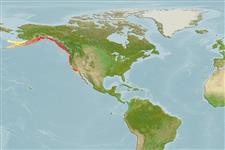>
Perciformes/Scorpaenoidei (Scorpionfishes) >
Sebastidae (Rockfishes, rockcods and thornyheads) > Sebastinae
Etymology: Sebastes: Greek, sebastes = august, venerable (Ref. 45335); paucispinis: From the Latin pauci and spinus, connoting 'few' and 'spine' (Ref. 27436).
More on author: Ayres.
Environment: milieu / climate zone / depth range / distribution range
экология
морской ассоциированный с рифами; пределы глубины 0 - 476 m (Ref. 27437). Subtropical; 65°N - 31°N
Eastern Pacific: Stepovak Bay, Alaskan Peninsula to Punta Blanca, Baja California, Mexico.
Length at first maturity / Size / Вес / Возраст
Maturity: Lm 48.0, range 36 - ? cm
Max length : 91.0 cm TL самец/пол неопределен; (Ref. 2850); наибольший вес (опубликованные данные): 9.6 kg (Ref. 4690); наибольший возраст (опубликованны данные): 50 годы (Ref. 75794)
Краткое описание
определительные ключи | морфология | морфометрия
колючие лучи спинного плавника (общее число) : 13 - 15; членистые (мягкие) лучи спинного плавника (общее число) : 13 - 16; колючие лучи анального плавника: 3; членистые (мягкие) лучи анального плавника: 8 - 10; позвонки: 26. A large rockfish with weak head spines - nasal and parietal spines usually absent, preocular, supraocular, postocular, tympanic, coronal and nuchal spines absent (Ref. 27437). Lower jaw long, thickened, with no real symphyseal knob and projects past upper jaw; maxillary extends to behind the eye; parietal ridges parallel (Ref. 27437). Caudal slightly indented (Ref. 6885). Olive orange to burnt orange or brown in color (Ref. 27437). Branchiostegal rays: 7 (Ref. 36715).
Adults found over rocky reefs, but also common on open bottoms to about 320 m (Ref. 2850). Juveniles are pelagic and settle in near shore nursery areas, then move to deeper habitats (Ref. 36715). Young form schools (Ref. 2850). Feed mainly on fishes, including other rockfishes (Ref. 2850). Ovoviviparous, with planktonic larvae (Ref. 36715, 6885, 34817). Validated age by radiometry is 37 yrs (Ref. 75794). A famous sport fish throughout its range (Ref. 2850). Flesh is of excellent quality when kept chilled (Ref. 27436). Sold with other rockfish species (Ref. 27436).
Eschmeyer, W.N., E.S. Herald and H. Hammann, 1983. A field guide to Pacific coast fishes of North America. Boston (MA, USA): Houghton Mifflin Company. xii+336 p. (Ref. 2850)
Статус Красного Списка МСОП (Ref. 130435)
Использование человеком
рыболовство: не имеет хозяйственного значения; объект спортивного рыболовства: да; аквариум: общественные аквариумы
дополнительная информация
инструменты
Специальные отчеты
Скачать в формате XML
ресурсы в Интернет
Estimates based on models
Preferred temperature (Ref.
123201): 4.5 - 8.9, mean 5.9 °C (based on 177 cells).
Phylogenetic diversity index (Ref.
82804): PD
50 = 0.5000 [Uniqueness, from 0.5 = low to 2.0 = high].
Bayesian length-weight: a=0.01000 (0.00499 - 0.02004), b=3.09 (2.92 - 3.26), in cm total length, based on LWR estimates for this Genus-body shape (Ref.
93245).
Trophic level (Ref.
69278): 3.5 ±0.46 se; based on food items.
устойчивость к внешним воздействиям (Ref.
120179): низкий, минимальное время удвоения популяции 4.5-14 лет (tm=4; tmax=50; Musick et al. 2000 (Ref.
36717)).
Prior r = 0.25, 95% CL = 0.17 - 0.38, Based on 2 full stock assessments.
Fishing Vulnerability (Ref.
59153): High vulnerability (63 of 100).
Climate Vulnerability (Ref.
125649): Moderate to high vulnerability (45 of 100).
Nutrients (Ref.
124155): Calcium = 11 [4, 34] mg/100g; Iron = 0.34 [0.13, 0.81] mg/100g; Protein = 19.2 [18.0, 20.4] %; Omega3 = 0.4 [0.2, 1.0] g/100g; Selenium = 66.5 [22.9, 204.1] μg/100g; VitaminA = 52.6 [18.2, 150.1] μg/100g; Zinc = 0.446 [0.224, 0.863] mg/100g (wet weight);
